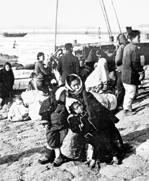
“Between Mountains: Refugee Life during the Korean War, 1948–1953” is the first systematic history of refugees and civilian livelihood during the war published in any language. There have been numerous politicized and political histories of the conflict that is called the Korean War (1950–1953) outside of the peninsula, the June 25th War (yugio chŏnjaeng六二五戰爭) in the Republic of Korea (ROK), and the Fatherland Liberation War (choguk haebang chŏnjaeng 祖國解放戰爭) in the Democratic People’s Republic of Korea (DPRK).
In contrast, scholarship on the civilian and social history of the war has been comparatively sparse in English and Korean. The dearth of information on non-combatants, however, did not mean that there was little activity among ordinary people. In South Korea alone, over five million people fled violence in the first year of the conflict, and two years into the war, roughly half of the population, 10 million people, were identified as war sufferers. Therefore, this project explores the history of refugees, defined broadly as those who crossed the thirty-eighth parallel separating North and South Korea, war sufferers, and the internally displaced
Although the war’s general effects on North Korea will be examined, due to the lack of access to the majority of North Korean sources, Janice C.H. Kim focuses on the history of refugee life in South Korea. The project assessed the details of and changes in the numbers of refugees, their routes of passage, their methods of survival, and institutional assistance for war sufferers. She also investigated how fratricidal warfare influenced the creation of welfare mechanisms and, by extension, differing visions of civil society in the two Koreas.
This project was funded by a Social Sciences and Humanities Research Council (SSHRC) Standard Grant.
